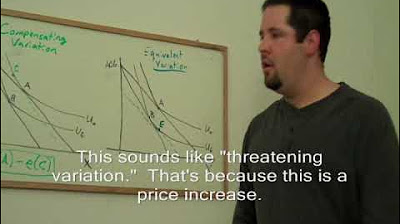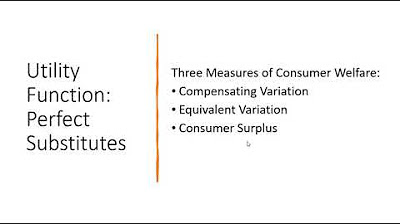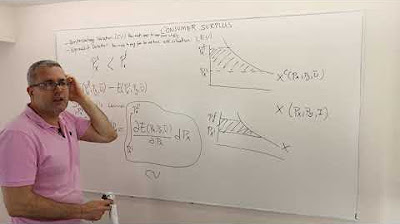Consumer Welfare: Compensating Variation & Equivalent Variation
TLDRThis educational video explores the concepts of compensating and equivalent variation in consumer welfare. It uses a hypothetical scenario where a person moves from City A to City B, demonstrating how to calculate the additional income needed (compensating variation) to maintain the same utility level despite price changes. The video also explains how much income reduction (equivalent variation) would decrease utility by the same amount as the price increase. The example involves a utility function with perfect complements and a budget constraint, illustrating the calculations clearly.
Takeaways
- 📚 The video discusses consumer welfare, focusing on compensating variation and equivalent variation in the context of moving from City A to City B.
- 🔍 The utility function for a person in City A is given as a perfect complements utility function, with income and prices for goods X and Y specified.
- 💰 The budget constraint in City A is derived from the income and prices of goods X and Y, leading to the determination of the quantities of goods that maximize utility.
- 🔄 The person's utility in City A is calculated using the quantities of goods purchased, resulting in a specific utility level.
- 🏙️ Moving to City B, the price of good Y increases, but the utility function and income remain unchanged, necessitating a new budget constraint.
- 📈 The compensating variation is defined as the additional money needed to offset the price increase and maintain the same utility level.
- 🔢 Through calculations, it is determined that an additional $1,250 is required in City B to achieve the same utility as in City A.
- 🔧 The equivalent variation is the amount of income reduction that would result in the same utility decrease as the price increase in City B.
- 📉 The equivalent variation calculation shows that an income of $4,000 in City A with lower prices would provide the same utility as $5,000 in City B with higher prices.
- 🤔 The video emphasizes the concept of utility maximization and how price changes can be offset by income adjustments to maintain consumer welfare.
- 📚 The video concludes by summarizing the calculations and concepts, aiming to provide a clear understanding of compensating and equivalent variations.
Q & A
What is the main topic of the video?
-The main topic of the video is consumer welfare, specifically focusing on compensating variation and equivalent variation in the context of a hypothetical move from City A to City B.
What is a perfect complements utility function?
-A perfect complements utility function is a type of utility function where two goods are consumed in fixed proportions, meaning one good is consumed twice as much as the other.
What are the prices of goods X and Y in City A?
-In City A, the price of good X is $1 and the price of good Y is $2.
What happens to the price of good Y when the person moves to City B?
-When the person moves to City B, the price of good Y increases to $3, while the price of good X remains unchanged at $1.
How is the budget constraint in City A derived?
-The budget constraint in City A is derived by setting the income equal to the price of good X times the units of good X plus the price of good Y times the units of good Y.
What is the definition of compensating variation?
-Compensating variation is the amount of money that needs to be given to a consumer to completely offset a price increase, so that the consumer's utility remains unchanged.
What is the utility function evaluated at the optimal consumption levels in City A?
-The utility function evaluated at the optimal consumption levels in City A is 2500 units, where the consumer buys 2500 units of good X and 1250 units of good Y.
How much additional income would the consumer need in City B to maintain the same utility level as in City A?
-The consumer would need an additional $1250 in City B to maintain the same utility level as in City A, given the higher price of good Y.
What is the definition of equivalent variation?
-Equivalent variation is the amount of money that needs to be taken away from a consumer to lower their utility by the same amount as a price increase.
What is the utility level in City B when the consumer's income is $5000 and the prices are adjusted?
-The utility level in City B when the consumer's income is $5000 and the prices are adjusted is 2000 units, with the consumer buying 2000 units of good X and 1000 units of good Y.
What would be the consumer's income in City A to provide the same utility as in City B with the higher prices?
-The consumer's income in City A would need to be $4000 to provide the same utility as in City B with the higher prices, assuming the lower prices of goods X and Y.
Outlines
💼 Consumer Welfare and Price Changes Analysis
This paragraph introduces the video's focus on consumer welfare, specifically compensating and equivalent variations. It discusses a hypothetical scenario where a person moves from City A to City B, with an unchanged utility function and income, but a price change for good-y. The compensating variation is defined as the amount needed to offset the price increase and maintain the same utility level. The utility function for a consumer with a perfect complements utility function is maximized by setting units of goods x and y in a specific ratio, given the budget constraint. The example provided calculates the compensating variation required for the consumer to maintain the same level of utility in City B as in City A, due to the increased price of good-y.
💸 Calculating Equivalent Variation in Price Sensitivity
The second paragraph delves into the concept of equivalent variation, which is the amount of income reduction that would result in the same utility level decrease as caused by the price increase. It uses the same utility function and budget constraint approach but starts with the assumption of City B's price structure and income. The calculation shows the income level that would provide the same utility as the higher prices in City B, if the consumer had lower prices in City A. The equivalent variation is determined by the difference in income that would yield the same utility under different price scenarios. The paragraph concludes by reiterating the idea that different combinations of income and prices can result in the same level of utility, emphasizing the sensitivity of consumer utility to price changes.
Mindmap
Keywords
💡Consumer Welfare
💡Compensating Variation
💡Equivalent Variation
💡Utility Function
💡Perfect Complements
💡Budget Constraint
💡Indifference Curve
💡Price Increase
💡Income
💡Maximizing Utility
Highlights
The video discusses consumer welfare in the context of compensating and equivalent variations.
The scenario involves a hypothetical move from City A to City B with a change in the price of good-y.
The person's utility function is given as a perfect complements utility function.
Income and the price of good-x remain constant, while the price of good-y increases in City B.
Compensating variation is defined as the amount needed to offset the price increase and maintain the same utility level.
The utility function is maximized by setting the ratio of goods x to y equal to each other.
In City A, the consumer buys 2,500 units of good-x and 1,250 units of good-y, resulting in a utility of 2,500 units.
For City B, the utility function is set to match the utility in City A, and the budget constraint is adjusted for the new prices.
In City B, the consumer would need an additional $1,250 to maintain the same utility level with the higher price of good-y.
Equivalent variation is the amount of money to take from the consumer to lower their utility by the same amount as the price increase.
The utility in City B is maximized with the new price structure, resulting in a lower utility level.
To achieve the same utility as in City B with lower prices, the consumer's income would need to be reduced to $4,000.
The equivalent variation is the difference in income, which is $1,000.
The video concludes by comparing the utility levels under different price and income scenarios.
The compensating variation and equivalent variation concepts are illustrated through a practical example.
The video provides a clear explanation of how changes in prices affect consumer welfare and the economic measures to quantify these effects.
The importance of understanding the impact of price changes on consumer utility is emphasized.
Transcripts
Browse More Related Video

How to Calculate Compensating Variation and Equivalent Variation

16. Compensating Variation and Equivalent Variation

Perfect Substitutes Utility: Compensating Variation, Equivalent Variation, and Consumer Surplus

Three Measures of Consumer Welfare: Compensating Variation, Equivalent Variation, Consumer Surplus

(M4E8) [Microeconomics] Consumer Surplus: Compensating and Equivalence Variations

Mathematically Solving for the Income and Substitution Effect of a Price Change
5.0 / 5 (0 votes)
Thanks for rating: